Personal Report of
ETRIA TFC 2016
Introductions to Individual Papers:
May 21, 2017 (in English)
Personal Report of
ETRIA TFC 2016 |
|
| D. Promotion of TRIZ in Industries (5 Papers) | |
| Toru Nakagawa (Osaka Gakuin Univ., Japan), May 21, 2017 (in English) |
|
| Posted on Jun. 4, 2017 |
For going to Japanese pages, press buttons.
Editor's Note (Toru Nakagawa, May 21, 2017)
This is a part of my 'Personal Report of ETRIA TFC 2016', whose parent page
was posted on Feb. 14, 2017. The Section (5) Introductions to Papers is going to be posted in 7 HTML pages, categorized with their topics for easier access.
A. Methodology of TRIZ
(Mar. 30, 2017)
B. Integral Use of TRIZ with Relevant Methods(Mar. 30, 2017)
C. Case Studies in Industries(Apr. 24, 2017)
D. Promotion of TRIZ in Industries(the present page) (Jun. 4. 2017)
E. Usage of TRIZ in Education and in Academia(Jun. 4, 2017)
F. Patent Studies(Jun. 21, 2017)
G. Applications to Soft & Non-technical Areas(Jun 21; Jul. 18, 2017)
Editor's Note (Toru Nakagawa, May 21, 2017) All the figures are shown here from the Authors' slides under the Authors' permissions.
D. Promotion of TRIZ in Industries ![]() marks are highly recommended.
marks are highly recommended.
D. Promotion of TRIZ in Industries
D1. A long-term strategy to spread TRIZ in SMEs. Analysis of Bergamo’s experience
Davide Russo, Daniele Regazzoni, Caterina Rizzi (University of Bergamo, Italy) ![]()
This is an excellent report of promoting TRIZ. Here is the Abstract by the Authors:
This work presents an analysis of a TRIZ dissemination program, still in progress, for the development of TRIZ in Bergamo area. The project, entitled "Development of methods and tools for the management and exploitation of intellectual property for the competitive growth of the Bergamo SMEs", has been carried out by the University of Bergamo and funded by the Chamber of Commerce of Bergamo and Lombardy Region since 2009.
Although the main objective has been to spread TRIZ methodology in SMEs, it was decided not to focus on the direct teaching of TRIZ but to provide a first support to SME owners or aspiring entrepreneurs. The easiest way to involve them was to use patents as first tool to provide technical and scientific advice on the subject of industrial property management (e.g., Protection tools, patentability opinions, trademark registration, modes and costs of filing/recording, realization of prior art searches, insights on counterfeiting, etc.) and then introducing systematic innovation tools. Patent issues were used as a “Trojan horse” to overcome the mistrust towards the structured methods and to stimulate the entrepreneurs to manage innovation in a more open way.
In the basis of this approach to innovation services, we have organized a series of awareness workshops and 5 days TRIZ courses with tutoring case study analyses and industrial follow-up. This allowed us to arrange, within the project, specialized consulting services with experienced professionals in the field of consultancy in technical-legal, contractual, economic, fiscal, marketing, or even of searches. In the last eight years, we have been collecting data that are analyzed and discussed in this paper. Pros and cons and some considerations on reproducibility and scalability of this model in other geographical contexts will be presented and discussed.
Since the slides by Authors are well-written in a compact manner, I will show most of them with brief introductions.
The slide (right) shows the Author's group at the University of Bergamo, Italy and its spin-off company. The group grew steadily into 14 members in 2015. The first and second co-authors of this paper, shown as '2 assistant professors', have been promoted lately to '2 associate professors'. The group has been publishing several papers every year at ETRIA TFC conferences.
The next slide (right) describes their views of the current status of TRIZ in the world. Their comments are quite objective, I think. In relation to the 1st point, we, the world wide TRIZ community, have 3 international associations, i.e., MATRIZ (International TRIZ Association, originally based in Russia), AI (Altshuller Institute for TRIZ Studies, based in USA), and ETRIA (European TRIZ Association), but we do not have a unique organization dedicated to growing and enhancing the standards of TRIZ. The focal issue of debates is between Conservatives (trying to stick to the classical TRIZ) and Progressives (promoting to modernize TRIZ). Thus in different countries TRIZ is taught and learnt in somewhat different manners reflecting cultural and geopolitical situations.
The Authors refer to 3 survey papers on the actual usage of TRIZ. They are a world-wide survey conducted by Denis Cavallucci (2009), a review on TRIZ by Ilevbare et al. (2013), a survey of case study papers by the Author's group (2015). Authors notice here that TRIZ users mostly use only few tools chosen from a large TRIZ Toolbox.
Then the Authors explain the situations of TRIZ in Italy (See the slide (right)). TRIZ is taught in official courses in a few universities, particularly in good cooperation among the TRIZ groups. Itarian TRIZ Association, which was active in holding two ETRIA TFC conferences at Florence (2004) and at Bergamo (2010), was closed in 2015, they say. Thus there are only local initiatives of TRIZ promoted by various local organizations.
The structure of industries in Italy is remarked. Micro enterprises represent 95% of total production units, while large ones (with over 250 employees) only 0.1%. This situation is quite different from those in highly-industrial coutries like USA, Germany, Japan, etc.
Nevertheless, the Authors put stress on the fact that the ratio of the number of patents granted (at EPO) to the R&D investments is relatively large for Italy in comparison to other EU countries (see slide (right), where Germany, France, UK, Italy, Spain, Finland, etc. are marked). So they say, there are many innovative enterprises sensible to innovation in Italy.
So far the Authors explain the background of the present project carried out in Bergamo..
Bergamo TRIZ projects started in 2009:
Bergamo is located near Milano in the north-west part of Italy. In Bergamo area there are over 11 thousands manufacturing industries, mostly SMEs, with a very high density.
TRIZ programs have been coducted in collaboration with three stakeholders, i.e., University of Bergamo, Bergamo Chamber of Commerce, and many enterprises. The Chamber of Commerce funds the TRIZ activities for SMEs. The University educates "graduates" (mostly Master degree) skillled in TRIZ and plays a large industrial consulting on TRIZ. The companies eagerly involved in the lessons of TRIZ. In this manner, collaboration has emerged synergy among these stake holders.
The slide (right) shows the TRIZ activities carried out by the University: (a) TRIZ official course for 80 hours, producing 50 Master Course graduate students in Mechanical Engineering every year. In the final exam of this course, companies provide unsolved problems to students; reports by students are evaluated by companies in the criteria of usefulness of the proposed solutions and by teachers in the criteria of appropriateness of the solution process. (b) TRIZ seminars in "Product lifecycle management" course is open for students of all the fields in the university. (c) TRIZ higher education course is meant to teach TRIZ to various SMEs openly. (d) Free short-term consulting sessions are open to SMEs mostly on IP, and the collaboration with SMEs and larger companies goes further ahead to training and consulting work on TRIZ and IP management.
Next slide (right) introduces the Bergamo Project in the aspects of collaboration between the University and the industries, with full support by Chamber of Commerce. Unique feature is to put emphasis on responding to industrial needs, instead of trying to teach/promote TRIZ. Thus the target is shown as "protection and promotion of IP to support innovation and competitiveness of SMEs". (1) IP guidance and customized technical suport service. Over 300 SMEs/Inventors were supported in 6 years. (2) Education and dissemination actions on IP and Innovation. E.g., Project Seminar, 3-day IP Course (x2), Advanced Seminar on IP and TRIZ (x4) every year. (3) TRIZ course and tutoring for SMEs (10 SMEs/year). In these activities Patents (or IP) play the role of Torjan Horse for spreading the understanding of TRIZ/Innovation.
The results of these activities have appeared as shown in the slide (right). Local newspapers reported interviews to SMEs who talk about their experiences in training and using TRIZ in their everyday activities. The Authors evaluate such newspaper reports very highly because they give credibility and authority to the method (IP with TRIZ) and to trainers (University TRIZ researchers). Professional association, i.e., Bergamo Chamber of Commerce, is promoting TRIZ and giving a sort of independent third-party certification. Large companies have published successful stories of their real cases on their official Web site.
Significant achievements of the Bergamo TRIZ Projects have been indicated in some more aspects as shown in the slide (right). A number of patents have been filed by the SMEs and by University of Bergamo with large companies. (They also say that the number of patents filed at Bergamo Patent Office per year is increasing recent years.)
The TRIZ course at the Univeristy gets popular among the students even of different specialties from mechanical engineering. And enterprises get increasingly interested in the graduating students who attended the TRIZ course at the University.
In parallel to the promotion activities in Bergamo TRIZ Projects, the Authors group has been developing innovative tools, both in theory/methods and in software. The software platform they developed is called SPARK. They intend to make the tools for helping beginners to apply TRIZ and also for experts to find information faster.
SPARK implements a process for designing a new product by solving various problems. The process has the main structure of 5 steps in sequence, where each step has several standard or optional substeps (or tools) shown as branches in the slide.
The slide (right) shows the strategy of developing SPARK. Marketing aspects are introduced to study the market demands and to setup the goal of the new products to be developed. Patent Intelligence is also an important feature, for surveying the current state-of-art, circunvating other's patents, finding directions of solutions, and building patent barriers, etc. A new search engine KOMPAT has been developed. TRIZ tools are improved partially as reported elesewhere.
All these aspects are incorporated into SPARK, which is based on TRIZ but largely reorganized.
The software platform has the 5 steps; i.e, (starting with Audit), Functional overview, Innovation strategy, Problem identification, Problem formulation, and Problem solving (resulting into New product). Main windows of these 5 steps are illustrated in the slide (right, bottom). (*** SPARK is reported partially at present.)
The slide (right) shows the Conclusions by the Authors.
All the points presented here are really convincing and important, I believe.
"We are still in the evangelization era of the (TRIZ) method. Every time we have to convince about the goodness and the benefits TRIZ can offer."
"Spreading TRIZ in SMEs is possible by planning a long term project and trying to involve not only enterprises but also institution playing the role of referees".
*** This paper is excellent not only because of its achievement of spreading TRIZ/Innovation method into many SMEs but becasue of its philosophy/strategy for improving/developing/spreading the TRIZ/Innovation method.
I already translated the full text and presentation slides of this paper into Japanese and posted them in the Japanese page
of "TRIZ Home Page in Japan" (Feb. 14, 2017). In the English page
, all the presentation slides are posted in this Web site, but the full paper is not yet officially published and not allowed to post in the Web. If you are much interested, you may ask the Authors via email.
D2. Combining TRIZ and open innovation, a new promising perspective for enhancing corporate innovation processes
Masih Hanifi (INSA Strasbourg, France), Remy Houssin (Univ. of Strasbourg, France), Denis Cavallucci, Simon Fuhlhaber (INSA Strasbourg, France)
Abstract by the Authors is cited here first:
TRIZ has been lately used to find inventive solutions to inventive problems. In nowadays context, open innovation is felt as being an alternative to a “stand-alone” thinking way and as such, is claimed as more powerful than methods like brainstorming. It is evident that TRIZ and Open Innovation propose both similar ways of functioning (learning from other domain or searching from other people or companies) and different ones (using models extracted from old data or using real life partners).
In this paper we report about a research project aiming a combining Open Innovation benefits and TRIZ strong points. We used the most widely used tool of TRIZ (Altshuller’s Contradiction Matrix) and associated to each inventive principle, a company known for being a good candidate for mastering the application of a given principle. We investigate innovative start-up companies and tagged their peculiarities in order to associate them not only to the principles but also to the way of filtering them. Consequently, we started to create a database which lists innovative SMEs that are felt as being an interesting partner in the context of the implementation of the 40 inventive principles. The paper presents the background, the methodology and a real life test to compare a classical use of the matrix, a test using our methodology and our web-interface. The conclusion is that the use of our methodology brings significant results in terms of “placing a given company in a pro-active direction”.
The motive of the Authors are shown in the following 3 slides. Problem (or weakness) in TRIZ exists in the process of implementing the solutions which area suggested with TRIZ in general words (e.g., Inventive principles) into real solutions. So the Authors are trying to introduce the Open Innovation strategy into the implementation process. But there is a basic problem in the Open Innovation how to find the right partners. The Authors are proposing to find such partners by use of Inventive principles as the linking keys.
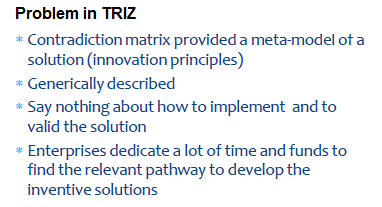
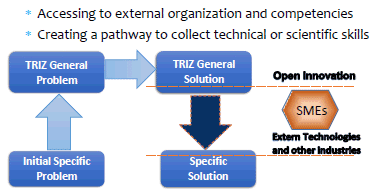
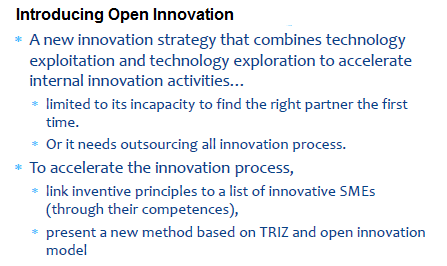
Combining Open Innovation with TRIZ, the Authors propose 'Open-TRIZ-Innovation Methodology'. Its 4 steps are described below briefly, illustrating with examples of actual SMEs in the Strasbourg region.
Step 1 is to list up all possible candidates of enterprises, which are mostly young start-ups, agile and inventive, and located in Alsas Region. This was done by searching the open database of French ARI (Research and Innovation Agency) and then reading individual companies' Web sites, catalogs, patents, etc. to find their know-how. Such innovative start-ups, found competent in creating specific characteristics in the new products presented to the market, are attributed with their product characteristics and their skills (see an example in the slide (right)).
Then in Step 2, the product characteristics are interpreted (by the Authors) in terms of TRIZ Inventive principles effectively used for them (in phase 1 of Step 2).
The information thus obtained for many SMEs are converted into a single table (or DB) for accessing the SMEs with the keys of 'Used Inventive principles' and necessary (or rather used) skills.
In this manner, the core competencies of many start-ups are characterized in terms of the TRIZ Inventive principles. This provides a useful means to find candidate start-up partners for cooperation.
The scheme of the Web-based application intended by the Authors is illustrated in the slide (right).
INSA (or Authors group) is to develop the Enterprise DB, in the manner described so far. The list of enterprises having innovative characteristics are developed and updated by INSA. Enterprises are included in the DB on one side, and can search, on the other side, for other innovative enterprises as their possible open-innovation partners.
The Authors show an example of their interface for finding good partners. Two companies to be matched are shown side by side in a window.
The Authors describe a case study of finding partners by using this method.
D3. Is Poland an innovative country?
Dorota Chybowska, Leszek Marek Chybowski (Maritime Univ. of Szczecin, Poland)
Abstract by the Authors is cited here:
The potential for innovativeness is difficult to measure, though many have attempted to do so. In order to look at Poland’s innovation potential, its current position and its opportunity to grow, compared with developing and developed countries, this study analysed the patent statistics of the Polish and European Patent Offices. Poland has been a member of the European Union for over a decade now. Therefore, we took into consideration the statistics for patent applications and grants for the last decade, up to the first quarter of 2016. The questions we wanted to answer concerned not only the technology fields that Poland patented its inventions in, but also the types of patent grantees and applicants. In order to determine why Poland is still considered to be only a moderate innovator by the Innovation Union Scoreboard, we also gathered information on Polish inventors abroad in 2015 and the first quarter of 2016, to see their number, technology fields, and types of patent grantees. Finally, we attempted to identify the main barriers that seem to inhibit Polish technology and innovation growth, despite significantly growing R&D intensities (up from 0.56 GDP and EUR 1,139 M in 2004 to 0.94 GDP and EUR 3,864 M in 2014).
I would like to cite 4 slides of statistics from the Authors' presentation:
(a) Number of Polish patents in the Polish Patent Office (UR RP) (orange, tall) and in the European Patent Office (EPO) (brown, small) for year 2008 - 2015
(b) Poland vs selected developed countries -- patent grants by the European Pat 2006-2015ent Office (EPO)
(c) Fields of technology of Polish inventors in Polish and foreign patents 2015 according to the International Patent Classification -- in European Patent Office (EPO)
(d) Regional distribution of Polish patent grantees in 2015 – Polish Patent Office (UP RP)
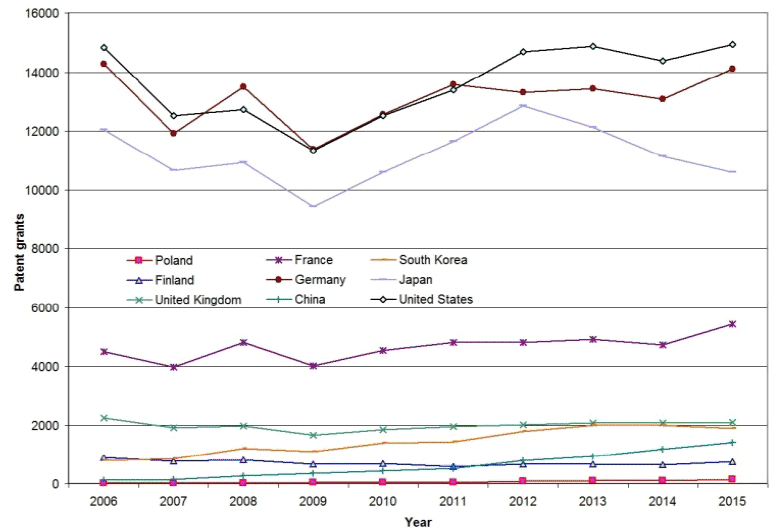
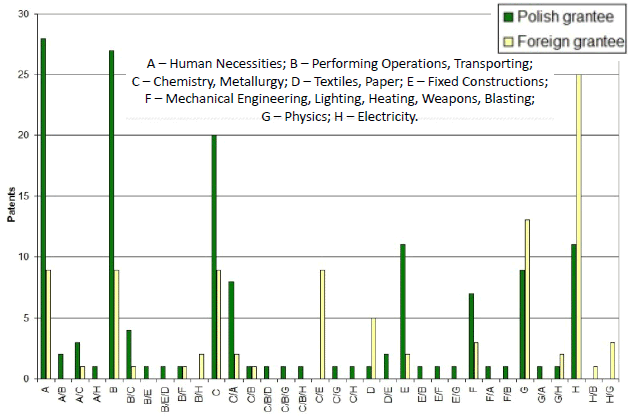
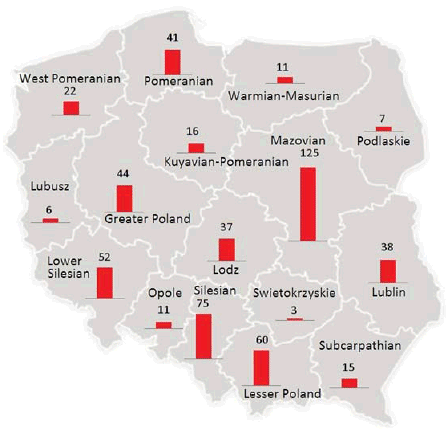
D4. R&D in Poland – is the country close to a knowledge-driven economy?
Dorota Chybowska, Leszek Chybowski (Maritime Univ. of Szczecin, Poland)
Abstract by the Authors is cited here:
Poland has a strong ambition to evolve rapidly into a knowledge-driven economy. Since 2004, it has been the largest beneficiary of European Union cohesion policy funds among all member states. Between 2007 and 2013, Poland was allocated approximately EUR 67 billion, whereas for 2014–2020 the EU budget earmarked EUR 82.5 billion for Polish cohesion policy. This means that in the coming years, Poland’s R&D intensity will grow. But the question remains: is 27 years of free market economy enough to enable a country’s economy to become knowledge-based?
This paper offers an analysis of Polish R&D expenditures and investments in terms of their sources (business, government or higher education sectors), types (European Union or state aid) and areas of support (infrastructure, education or innovation). It also characterises the Polish R&D market with its strengths and weaknesses. Then, it examines the process of technology transfer in Poland, comparing it to best practice. Finally, the paper lays out the barriers to effective commercialisation that need to be overcome, and attempts to answer the question raised in its title.
The Authors adopt a four-step model of economy development.
Since it is not easy for me to summarize the contents and discussions in this paper, I will quote the last paragraph of the Authors' conclusion:
Summarizing, there are still many years of hard work and investments ahead if Poland is to make headway toward a knowledge-driven economy. The stage Poland is at now is mainly the consequence of the unfavorable historical events of the 20th century and the enormous destruction that followed. However, dynamic changes occurring in Poland in recent years at governmental, social and economic levels, as well as the support provided by the EU will certainly allow Poland to close the gap with other developed economies. A goal that Poland is very ambitious about.
D5. Why TRIZ Popularity is Declining
Sergey Sobolev (Siemens LLC, Russia), Oleg Abramov (Algorithm Ltd., Russia)
This presentation raised much discussions and arguments at the Conference. Here is the Abstract by the Authors:
In this paper, the authors investigate the following issues: (1) popularity of TRIZ around the world (2) how industry is currently using TRIZ to develop new products/processes; and (3) why TRIZ, although highly effective, does not yet enjoy the recognition it deserves.
The results of this research have revealed that TRIZ is still one of the least known and least popular innovation methodologies in the world; furthermore, world interest in TRIZ is declining; TRIZ does have a currently recognized niche in the innovation process, but it is limited to generating solutions for technical problems.
The overall conclusion is: in its current form, TRIZ is approaching the maturity, if not stagnation, stage of its evolution and further development of TRIZ should include (a) the development of business-oriented TRIZ tools to be used at both the early and later stages of new product/process developments, and (b) close integration with existing best industry practices for developing new products/processes.
(2) In the 2 graphs (below), Authors show the results of 'Google Trend' for the keyword search of 'TRIZ' (in comparison of 'Innovation'), by referencing the Web article by David Patrishkoff [
, unfortunately this link is broken (May. 8, 2017)]. During the years from 2004 to 2013, people's interest in TRIZ decreased 55 % while that in Innovation decreased only 25 %. The ordinates are normalized with the total number of Web search of all the keywords. The ratio of interest in TRIZ against interest in Innovation is not shown in the paper. [*** More detailed work was reported originally by Ido Lapidot et al. at ETRIA TFC 2013, accessible for ETRIA Members at ETRIA Web site
. They say that interest in TRIZ never exceed 5% of that in Innovation.]
(3) The Authors made keyword searches for TRIZ and other relevant methods on Google to find the numbers of hits of pages. The results are shown in the bar graph (right). Lean method has 44 million pages, while TRIZ 0.5 million. The Authors write "This seems to be an accurate representation of how little the world knows about TRIZ compared to the other methodologies for innovating considered in the current research."
On the basis of these statistics, the Authors discuss as shown in the slide (below left). And then they conclude as summarized in the slide (below right).
|
|
*** We need to be objective, thoughtful, and wide-viewed in considering the issues raised by the present paper. The situations of TRIZ (and similar methods) are not easy to reveal objectively. The most thorough survey of the usage of TRIZ in the world was conducted as an ETRIA project by Denis Cavallucci as reported publicly in ETRIA TFC 2009
. The project posted an open inquiry asking how TRIZ has been used in individual persons, organizations, countries, etc. With the support by representatives of 34 countries, they received answers from 319 people from 39 countries. It gave a rough overview on the perception and penetration of TRIZ in the world, even though actual situations were still vague. One of the aspects it clarified was that almost all developed countries in the world had access to TRIZ and the stake-holders were belonging to 3 categories, i.e. consultants, research/education, and industry, in a balance. Since this survey in 2009, TRIZ has been more widely adapted especially in mid-developed countries.
Results of usage of TRIZ in industries are often difficult to be published, for both excellent ones and poor ones. Results of research on TRIZ also meet some difficulties to be published because they are often more practical than academic in nature and have not found yet proper positions in academic categories. TRIZ is also not popular yet in business management. All these factors form the barriers for TRIZ, as a new methodology, to overcome for becoming a widely spread, important methodology for systematic innovation. It is understood among most people in the TRIZ community that TRIZ is struggling for overcoming these barriers for years. Recent decrease in the number of Web searches for TRIZ (in the statistics (2)) and staying rather small number in the count of Web pages on TRIZ do reflect the current difficulties with these barriers.
Thus we have to consider how to overcome such barriers. Authors of the present paper suggest the points in their Conclusions (see the slide (above)). Different Authors, who presented their papers at this (TFC2016) or any other conferences, are proposing their own approaches for overcoming the barriers. In this sense, we should not try to pick up a few proposals but rather work to learn various good approaches (in TRIZ and relevant fields). We can learn various methodological approaches and various application results, in this TFC 2016 Conference as well as many other places.
The TRIZ community should collect and review the whole advances of TRIZ for these 3 decades, namely after 1985 when Classical TRIZ was set/fixed. This means to clarify 'What are the Modernized TRIZ Methodology and its applications'. We should apply the thinking process of 'Diverge and then Converge' or 'Complicate and then Simplify'. The result would be the new generation(s) of TRIZ. There can be a few versions of new TRIZ depending on the different purposes of applications.
Last updated on Jul. 18, 2017. Access point: Editor: nakagawa@ogu.ac.jp